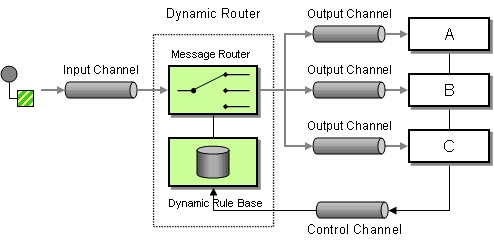Dynamic Router
来源:互联网 发布:python 贝叶斯分类 编辑:程序博客网 时间:2024/05/17 04:34
http://camel.apache.org/dynamic-router.html
Dynamic Router
The Dynamic Router from the EIP patterns allows you to route messages while avoiding the dependency of the router on all possible destinations while maintaining its efficiency.

In Camel 2.5 we introduced a dynamicRouter in the DSL which is like a dynamicRouting Slip which evaluates the slip on-the-fly.
You must ensure the expression used for the dynamicRouter such as a bean, will returnnull to indicate the end. Otherwise the dynamicRouter will keep repeating endlessly.
Options
Dynamic Router in Camel 2.5 onwards
From Camel 2.5 the Dynamic Router will set a property (Exchange.SLIP_ENDPOINT) on the Exchange which contains the current endpoint as it advanced though the slip. This allows you to know how far we have processed in the slip. (It's a slip because theDynamic Router implementation is based on top of Routing Slip).
Java DSL
In Java DSL you can use the dynamicRouter as shown below:
from("direct:start") // use a bean as the dynamic router .dynamicRouter(method(DynamicRouterTest.class, "slip"));
Which will leverage a Bean to compute the slip on-the-fly, which could be implemented as follows:
/** * Use this method to compute dynamic where we should route next. * * @param body the message body * @return endpoints to go, or <tt>null</tt> to indicate the end */public String slip(String body) { bodies.add(body); invoked++; if (invoked == 1) { return "mock:a"; } else if (invoked == 2) { return "mock:b,mock:c"; } else if (invoked == 3) { return "direct:foo"; } else if (invoked == 4) { return "mock:result"; } // no more so return null return null;}
Mind that this example is only for show and tell. The current implementation is not thread safe. You would have to store the state on theExchange, to ensure thread safety, as shown below:
/** * Use this method to compute dynamic where we should route next. * * @param body the message body * @param properties the exchange properties where we can store state between invocations * @return endpoints to go, or <tt>null</tt> to indicate the end */public String slip(String body, @Properties Map<String, Object> properties) { bodies.add(body); // get the state from the exchange properties and keep track how many times // we have been invoked int invoked = 0; Object current = properties.get("invoked"); if (current != null) { invoked = Integer.valueOf(current.toString()); } invoked++; // and store the state back on the properties properties.put("invoked", invoked); if (invoked == 1) { return "mock:a"; } else if (invoked == 2) { return "mock:b,mock:c"; } else if (invoked == 3) { return "direct:foo"; } else if (invoked == 4) { return "mock:result"; } // no more so return null return null;}
You could also store state as message headers, but they are not guaranteed to be preserved during routing, where as properties on theExchange are. Although there was a bug in the method call expression, see the warning below.
Mind that in Camel 2.9.2 or older, when using a Bean the state is not propagated, so you will have to use a Processor instead. This is fixed in Camel 2.9.3 onwards.
Spring XML
The same example in Spring XML would be:
<bean id="mySlip" class="org.apache.camel.processor.DynamicRouterTest"/><camelContext xmlns="http://camel.apache.org/schema/spring"> <route> <from uri="direct:start"/> <dynamicRouter> <!-- use a method call on a bean as dynamic router --> <method ref="mySlip" method="slip"/> </dynamicRouter> </route> <route> <from uri="direct:foo"/> <transform><constant>Bye World</constant></transform> <to uri="mock:foo"/> </route></camelContext>
@DynamicRouter annotation
You can also use the @DynamicRouter annotation, for example the Camel 2.4 example below could be written as follows. Theroute method would then be invoked repeatedly as the message is processed dynamically. The idea is to return the next endpoint uri where to go. Returnnull to indicate the end. You can return multiple endpoints if you like, just as theRouting Slip, where each endpoint is separated by a delimiter.
public class MyDynamicRouter { @Consume(uri = "activemq:foo") @DynamicRouter public String route(@XPath("/customer/id") String customerId, @Header("Location") String location, Document body) { // query a database to find the best match of the endpoint based on the input parameteres // return the next endpoint uri, where to go. Return null to indicate the end. }}
Dynamic Router in Camel 2.4 or older
The simplest way to implement this is to use the RecipientList Annotation on a Bean method to determine where to route the message.
public class MyDynamicRouter { @Consume(uri = "activemq:foo") @RecipientList public List<String> route(@XPath("/customer/id") String customerId, @Header("Location") String location, Document body) { // query a database to find the best match of the endpoint based on the input parameteres ... }}
In the above we can use the Parameter Binding Annotations to bind different parts of the Message to method parameters or use an Expression such as using XPath or XQuery.
The method can be invoked in a number of ways as described in the Bean Integration such as
- POJO Producing
- Spring Remoting
- Bean component
Using This Pattern
If you would like to use this EIP Pattern then please read the Getting Started, you may also find the Architecture useful particularly the description of Endpoint and URIs. Then you could try out some of the Examples first before trying this pattern out.
==========
http://camel.465427.n5.nabble.com/Exchange-headers-properties-and-dynamic-routers-td3406684.html
Exchange headers/properties and dynamic routers
- router.dynamic
- Dynamic Router
- Dynamic Router
- linux #raspberrypi router with dynamic dns
- router
- Router
- router
- dynamic
- @dynamic
- Dynamic
- @dynamic
- dynamic
- dynamic
- dynamic
- @dynamic
- @dynamic
- router commands
- NetWork-router
- Fedora wifi8192cus驱动问题
- pomelo学习笔记 (4) libpomelo 编译静态库加入cocos2d-x xcode 项目
- PHP生成一维码、二维码方法
- git项目的trunk步骤
- How to install FlexPMD in Flex Builder 4.5
- Dynamic Router
- struts
- /proc 伪文件系统
- nfs网络文件系统挂载笔记整理1
- KMP算法
- Comet 与传统的 Ajax 轮询相比性能方面是否占优?
- CDN内容分发网络简介
- C# timer简单使用方法小结
- cocos2d-x跨android&ios平台开发入门教程part-1


